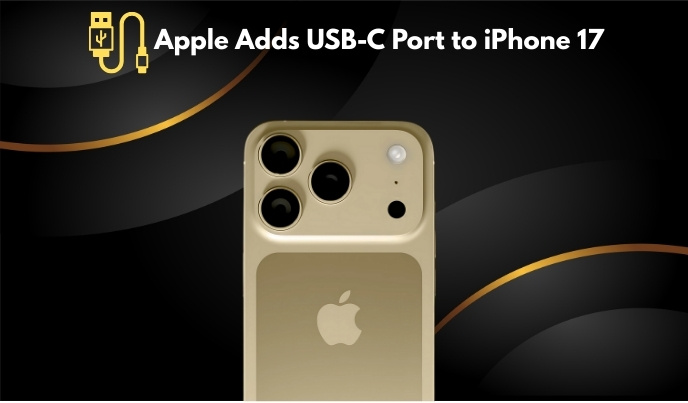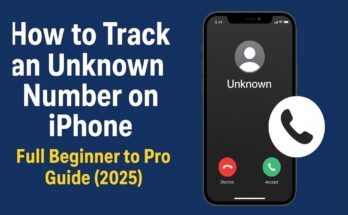
Apple has finally taken the leap. With the iPhone 17, the company has replaced its long-standing Lightning connector with the much-requested USB-C port. For over 11 years, Lightning was part of the iPhone’s identity, but change was inevitable.
So why does this matter? For many users, it’s not just a new charging port—it’s a complete shift in how iPhones connect with the world. From faster charging to universal compatibility, the move to USB-C could transform your daily iPhone experience.
In this blog, we’ll cover:
- Why Apple made the switch.
- Benefits of the USB-C port.
- How it compares to Lightning.
- Real-world use cases.
- Expert opinions and FAQs.
Why Did Apple Add USB-C to the iPhone 17?
1. European Union Regulations
The European Union passed legislation in 2022 requiring all smartphones sold in Europe to adopt a universal charging standard by 2024. The standard chosen: USB-C.
Apple had no choice but to comply. But beyond legal requirements, the move has global advantages.
2. User Demand
Apple users have long wanted fewer cables. Many already use USB-C for MacBooks, iPads, external drives, and even gaming consoles. By adding USB-C to iPhone 17, Apple finally creates a single-cable ecosystem.
3. Industry Alignment
Nearly every smartphone maker—from Samsung to Google—already uses USB-C. By joining this standard, Apple reduces friction for users switching between devices.
|| May You love to read How Do You See Blocked Messages on iPhone: Hidden Messages
What Makes the USB-C Port So Important?
The USB-C port is more than a charging connector. It’s a universal standard that handles charging, data transfer, audio, and video.
Key Benefits of USB-C Port
- Reversible design (plug it in any way).
- Fast charging (up to 35W or more).
- Super-fast data transfer (up to 40 Gbps with Thunderbolt).
- Universal use across thousands of devices.
Table 1: Lightning vs USB-C Port Overview
| Feature | Lightning Port | USB-C Port (iPhone 17) |
|---|---|---|
| Reversible | Yes | Yes |
| Charging Speed | 20W Max | 35W+ Max |
| Data Transfer Speed | 480 Mbps | Up to 40 Gbps |
| Compatibility | Apple-only | Universal |
| Accessory Support | Limited | Expanded (mics, hubs) |
Benefits of USB-C on iPhone 17

Faster Charging Speeds
With Lightning, iPhones capped out around 20W charging. With USB-C, iPhone 17 can charge at 35W or higher, depending on the charger.
- iPhone 16 (Lightning): 0–50% in 30 minutes.
- iPhone 17 (USB-C): 0–50% in 20 minutes.
That’s nearly 40% faster charging.
Better Data Transfer
Lightning was stuck at USB 2.0 speeds (480 Mbps). USB-C enables iPhone 17 to support USB 3.2 and Thunderbolt speeds up to 40 Gbps.
This matters most for:
- Videographers: Moving 4K/8K ProRes video files.
- Photographers: Transferring RAW images quickly.
- Gamers: Downloading and syncing large apps.
|| Also read this Most Protective Cases for iPhone 16 Pro – Expert Review
How USB-C Improves iPhone 17’s Everyday Experience
1. Universal Charging Across Devices
One of the biggest frustrations with iPhones was carrying a separate Lightning cable. With the iPhone 17’s USB-C port, you can now:
- Use the same cable for MacBooks, iPads, AirPods Pro (2nd Gen), and iPhone 17.
- Borrow a friend’s Android charger in emergencies.
- Reduce cable clutter while traveling.
This makes the iPhone 17 more eco-friendly, since fewer cables and chargers are needed.
2. Enhanced Accessory Support
The Lightning connector limited accessory compatibility. USB-C opens a new world of possibilities:
- External Storage: Plug in SSDs or flash drives to transfer files instantly.
- Professional Cameras: Connect DSLRs and mirrorless cameras.
- Audio Devices: High-res headphones, DACs, and microphones.
- Monitors: Stream video directly to external displays with HDMI adapters.
- Hubs & Docking Stations: Expand your iPhone into a productivity tool.
Table 2: Accessories You Can Now Use with iPhone 17 (USB-C)
| Accessory Type | Example Devices | Benefit for Users |
|---|---|---|
| External Drives | Samsung T7, SanDisk Extreme SSD | Faster backup of photos & videos |
| Cameras | Canon EOS R, Sony Alpha | Direct file transfer |
| Audio Equipment | Rode Mic, Focusrite Scarlett | Studio-quality recording |
| Displays & Monitors | 4K/5K Displays via HDMI adapters | Better presentation & content viewing |
| Hubs & Docking Stations | Anker USB-C Hub, CalDigit TS4 | Turn iPhone into workstation |
3. Speed for Professionals
USB-C is not just convenient—it’s a game changer for content creators.
- Photographers: Import thousands of RAW files directly.
- Filmmakers: Transfer ProRes 4K/8K videos in minutes, not hours.
- Musicians: Use professional audio gear without extra adapters.
In fact, many professionals already rely on MacBooks with USB-C ports. The iPhone 17 now fits seamlessly into that workflow.
Technical Breakdown: Lightning vs USB-C
Let’s take a closer look at the technical specs behind the shift.
Charging Standards Supported
The Lightning port used Apple’s proprietary charging system. USB-C on iPhone 17 supports:
- USB Power Delivery (USB-PD) – industry standard.
- Fast charging up to 35W.
- Potential MagSafe enhancements via USB-C.
Data Transfer Protocols
- Lightning: Stuck at USB 2.0 (480 Mbps).
- USB-C (iPhone 17): Supports USB 3.2 (10 Gbps) and Thunderbolt (40 Gbps) on Pro models.
This makes the Pro versions of iPhone 17 especially appealing to creative professionals.
Pros and Cons of Apple’s Switch to USB-C
Like any change, the move has both advantages and challenges.
Table 3: Pros and Cons of USB-C on iPhone 17
| Pros | Cons |
|---|---|
| Universal compatibility | Older Lightning accessories become useless |
| Faster charging speeds | Requires new chargers for some users |
| Super-fast data transfers | Potential confusion (USB-C vs Thunderbolt) |
| Eco-friendly (fewer cables needed) | High-speed cables may cost more |
| Supports more accessories | Transition period may frustrate users |
Why This Shift Matters for Apple Fans
Apple’s move isn’t just about compliance with EU laws—it’s about shaping the future of iPhones. By embracing USB-C, Apple unlocks:
- Consistency across devices (Mac, iPad, iPhone).
- Global convenience (universal charging standard).
- Professional-grade performance for creators.
It also shows that Apple is listening to user demand, even if reluctantly.
Industry analysts believe this shift is long overdue. According to a report from The Verge, Apple’s adoption of USB-C makes the iPhone “future-ready for professional workflows.” Similarly, TechCrunch highlighted how photographers and videographers will benefit from faster transfers of ProRAW and ProRes files.
This isn’t just a small change—it’s a strategic evolution for Apple.
Frequently Asked Questions (FAQs)
1. Why did Apple switch from Lightning to USB-C?
Apple switched to USB-C to comply with new EU regulations requiring a universal charging port. Beyond legal reasons, the change also offers faster charging, higher data transfer speeds, and broader compatibility with accessories.
2. Will my old Lightning cables still work with iPhone 17?
No, the iPhone 17 no longer supports Lightning cables. You will need a USB-C cable. However, most Apple devices already use USB-C, so you might already own one.
3. Can I use any USB-C cable for charging?
Not all USB-C cables are the same. Basic cables work for charging, but for fast charging or high-speed data transfer, you’ll need a certified USB-C PD cable or a Thunderbolt 4 cable (for Pro models).
4. Does USB-C make the iPhone 17 charge faster?
Yes. With USB Power Delivery, the iPhone 17 can charge up to 50% in about 25 minutes with a 35W adapter. That’s noticeably faster than Lightning.
5. Can I connect my iPhone 17 to a monitor?
Yes, with the right USB-C to HDMI or DisplayPort adapter, you can connect your iPhone 17 directly to external monitors for presentations, videos, or even gaming.
6. Is the switch to USB-C better for the environment?
Yes. Since USB-C is a universal standard, users won’t need to buy as many extra cables. This reduces e-waste and supports Apple’s push toward sustainability.
Final Thoughts
The move from Lightning to USB-C may seem small, but it represents a major milestone for iPhones. It brings:
- Universal charging convenience across devices.
- Blazing-fast data transfer speeds for professionals.
- Improved accessory compatibility for everyday and creative use.
- Environmental benefits by reducing unnecessary cable waste.
For everyday users, it means fewer chargers to carry. For professionals, it means a smoother, faster workflow.
Apple has finally given users what they’ve been asking for: a truly modern iPhone port that keeps up with the rest of the tech world.
What’s Next?
Apple’s switch to USB-C raises questions about the future of iPhones. Could the iPhone 18 go fully portless, relying only on MagSafe and wireless data transfer? Or will USB-C stay as the universal standard for years to come?
One thing is clear: the iPhone 17 is more future-proof than any iPhone before it.
If you’re planning to upgrade, make sure to pick up a high-quality USB-C charger and explore the new accessories that unlock the full power of iPhone 17.
👉 Stay tuned here at [Your Blog Name] for more in-depth iPhone 17 tips, hidden features, and comparisons.


I know this if off topic but I’m looking into starting my own blog and was wondering what all is needed to get setup? I’m assuming having a blog like yours would cost a pretty penny? I’m not very web savvy so I’m not 100 certain. Any recommendations or advice would be greatly appreciated. Kudos
I couldn’t resist commenting